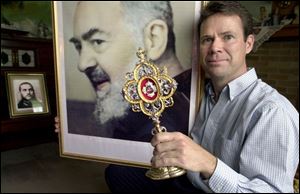
Close encounter with a saint
6/8/2002
Gerard Rusch of Fremont, holding a Padre Pio portrait and relic, is founder and coordinator of the Padre Pio Prayer Group of the Toledo Diocese. The Italian priest, who died in 1968, will be canonized June 16.
Robert Billmaier was a young - and skeptical - Air Force sergeant stationed in Italy during World War II when he and a buddy decided to check out a phenomenon they had read about in the Stars and Stripes military newspaper.
It was 1944 and an Italian priest named Padre Pio was reportedly attracting crowds at a church in San Giovanni Rotondo because he bore the stigmata - the wounds of Christ - on his hands. Several miracles had been reported as a result of his prayers and he also was said to be able to predict events in the future and tell people their sins.
“I was a 19-year-old who was raised Catholic, but I was still at an age where I was curious and doubtful and I thought, `This is some kind of a show somebody is putting on,'” Mr. Billmaier said.
When he and his friend arrived in San Giovanni Rotondo for the 6 a.m. Mass, the church was already filled. They tried around back and, thanks to Mr. Billmaier's buddy, who spoke Italian, were unexpectedly ushered inside and told to kneel at the altar steps. Then, when it came time for Padre Pio to wash his hands in preparation for communion, the two servicemen were directed to hand the priest a set of cruets containing water and wine and to hold a bowl so that water could be poured over his fingers.
For the entire Mass, they were able to observe the priest at close range.
At the prayers of consecration preceding communion, Mr. Billmaier said, a pair of black, fingerless gloves were removed from Padre Pio's hands. Under each was a white, fingerless mitten, which also was removed. During the prayers, blood began to ooze from wounds in the priest's hands. “A priest assisting him had a bowl with cotton in it and every so often, he would daub at the wounds,” Mr. Billmaier recalled.
After the Mass, everyone present received a blessing from Padre Pio, and outside, about 150 people lined up to have him hear their confessions. While Mr. Billmaier and his friend were looking on, an old man came out of the confessional with Padre Pio following him. “He was telling him he didn't confess all his sins and he'd better come back in.”
About 20 to 25 years ago, Mr. Billmaier started corresponding with the friary where Padre Pio lived and later with the National Center for Padre Pio in Barto, Pa. In the ensuing years, he has distributed scores of leaflets about the priest, who died in 1968, and prayed to him as well.
“A lot of people have benefited from his prayers of intercession for healing. ... I just feel this was a great man and a lot of people need someone like that.”
When he had knee surgery recently, Mr. Billmaier asked Padre Pio to be with him before he went under the anesthetic. “When I awoke in the recovery room, there was a light fragrance in the air so I knew the surgery was successful.” Mr. Billmaier also recalls smelling a sweet scent when he was at Padre Pio's Mass many years ago. “I thought someone in the group had perfume on, but during the prayers of consecration, the fragrance became most intense.”
As a deacon at St. Michael's Church in Findlay, Mr. Billmaier has talked about Padre Pio and his experience with him from time to time. “I don't go overboard because it's not for me that I say these things. I'm not the one trying to claim credit for my experience with him. He's the one that is the Christ figure because he has the stigmata.”
The Padre Pio canonization will be celebrated in Toledo with a solemn high Latin Tridentine Mass at 2 p.m. June 16 in Rosary Cathedral, followed by benediction, recitation of the Rosary and Litany of the Saints, and veneration of two relics. The Mass will be preceded by confessions at 1 p.m.
Sponsored by the Padre Pio Prayer Group of the Toledo Diocese, which meets monthly at the St. Bernardine Home in Fremont, the Mass is believed to be the first solemn high Latin Tridentine Mass at the Cathedral since the language of the Catholic liturgy was changed following the Second Vatican Council of the 1960s.
Gerard Rusch, founder and coordinator of the Padre Pio group, said he requested permission to have a Latin Mass for the canonization because it is the form of the ritual that Padre Pio celebrated his entire life.
Mr. Rusch started the Padre Pio group, which is one of about 50 in the United States and 2,100 worldwide, in 1998 at the urging of the Rev. Alessio Parente after making a pilgrimage to San Giovanni Rotondo in 1997. Father Parente cared for Padre Pio during the last eight years of the saint-to-be's life.
The priest later supplied the local group and its spiritual director with two relics that are considered “first class” because they had touched Padre Pio's body. Mr. Rusch said the relics are tiny pieces of gauze that covered the priest's stigmata. Each also contains blood from the wounds.